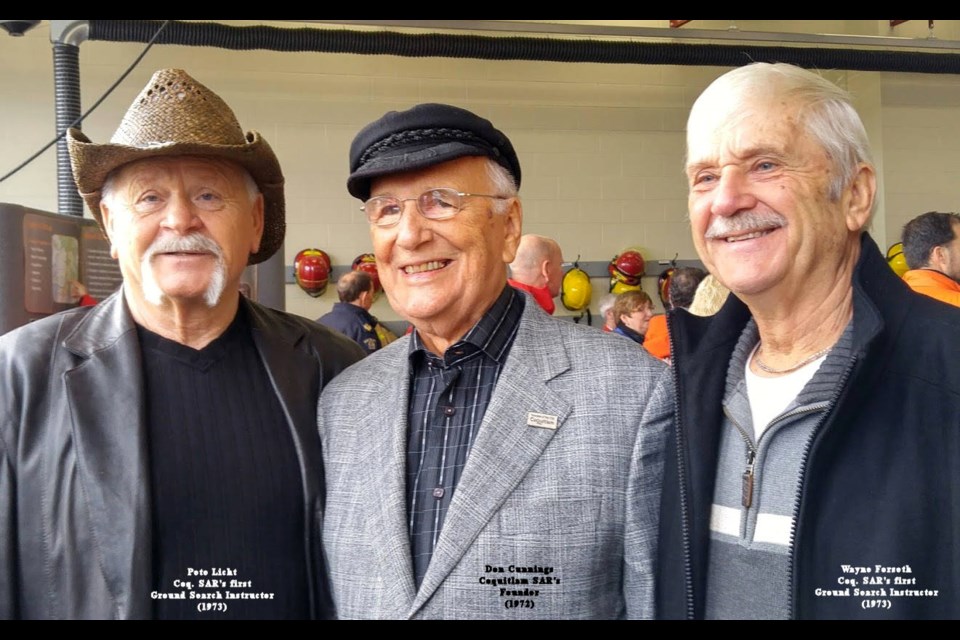This article is part of the Tri-City News' tribute to Coquitlam Search and Rescue, which celebrates 50 years in 2022.
In February 1972 — 50 years ago — two Port Coquitlam teenage boys found they could not resist the siren call (which often results in bad outcomes) to climb up to Burke Mountain’s Munro Lake, off Quarry Road in northeastern Coquitlam.
Tragically, this alluring call resulted in one of the boys losing his life on the mountain.
At the time, the one-and-only mountain search and rescue team in the Lower Mainland was located in North Vancouver.
Thus, it was to this team that a call for assistance was initiated by the Maillardville RCMP detachment, along with a call to the Comox RCAF Rescue Squadron.
The North Vancouver Volunteer Search and Rescue (SAR) Team arrived on Quarry Road early on Day 2 accompanied by two civil defence trucks from the Korean War era.
One vehicle served as an equipment truck, while the second vehicle served as the team’s mobile coffee and food truck — a welcomed vehicle on a very cold February morning.
Fortuitously, one of Maillardville’s RCMP detachment members, Const. Laurie Marshall, had just completed a Parks Canada Mountain Rescue Course in Alberta as part of his dog–master training.
That fact allowed Const. Marshall to serve as site commander for Coquitlam.
When the military helicopter arrived from Comox on Day 2, the North Vancouver SAR team members had already spotted the body of the young teenager in the Munro Creek drainage.
The Comox military helicopter crew retrieved the body from the frozen Munro Creek bed by using the aircraft’s winch-cable lift.
In the aftermath of this event, the District of Coquitlam’s park and recreation director focused his attention onto crafting a report and recommendation to the municipal council that would see council authorizing the establishment of a Coquitlam SAR team.
Not surprisingly, council approved the recommendation.
•••••
Aware that a goal without a plan is but a dream, the team’s founder adopted a three-phase action plan that involved
- a training component
- a recruitment component
- an equipment-acquisition component
PHASE 1
The need to recruit a top-notch search and rescue course instructor for the team was paramount.
Two fellow municipal employees immediately came to my mind.
The first was the supervisor of mapping for the district’s engineering department, Wayne Forseth.
The second municipal employee, Peter Licht, had recently transferred from the district’s engineering survey department into the district’s park and recreation department.
Both men were also auxiliary RCMP members.
My approach to both men carried with it an important prerequisite: They take a one-week SAR-advanced-instructor’s course in Victoria.
Tied to the training component was also the pivotal need for a training room.
To that end, I approached Insp. Marv Young, the newly appointed Officer In Charge (OIC) of the Coquitlam RCMP detachment. The inspector did not hesitate to approve the request.
PHASE 2
The ramp-up of Coquitlam’s Search and Rescue implementation plan now switched to team-member recruitment. I made the decision to limit the recruitment of Coquitlam SAR team members to uniformed fire and police.
PHASE 3
Finally, I now turned my energy to acquiring SAR’s first mobile command post.
To use the front seat of a police cruiser or the engine hood of a vehicle as a mobile command centre was anachronistic, and had proven so during the February 1972 Quarry Road search on Burke Mountain that led to the formation of today’s Coquitlam SAR team.
A Zodiac rescue boat and trailer were also added to the team’s equipment inventory.
To donate to Coquitlam Search and Rescue in its 50th year, visit www.coquitlam-sar.bc.ca.





